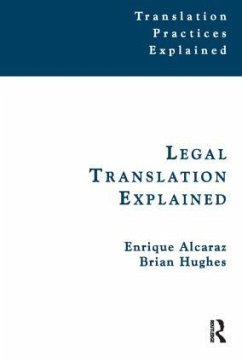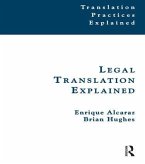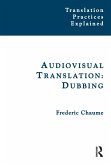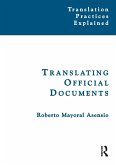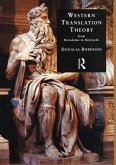- Broschiertes Buch
- Merkliste
- Auf die Merkliste
- Bewerten Bewerten
- Teilen
- Produkt teilen
- Produkterinnerung
- Produkterinnerung
Focusing on the problems of translating English legal language, Alcaraz and Hughes offer a wide-ranging view of one of the most demanding and vital areas of contemporary translation practice. Individual chapters deal with legal English as a linguistic system, special concepts in the translation of legal English, the genres of legal translation, and offer a series of practical problems together with discussions of proposed solutions, as well as insight into the pragmatic ways translators go about finding solutions.
The numerous examples and discussions of specific terms make the book useful…mehr
Andere Kunden interessierten sich auch für
![Legal Translation Explained Legal Translation Explained]() Enrique AlcarazLegal Translation Explained231,99 €
Enrique AlcarazLegal Translation Explained231,99 €![Audiovisual Translation Audiovisual Translation]() Frederic ChaumeAudiovisual Translation50,99 €
Frederic ChaumeAudiovisual Translation50,99 €![Translating Official Documents Translating Official Documents]() Roberto Mayoral AsensioTranslating Official Documents28,99 €
Roberto Mayoral AsensioTranslating Official Documents28,99 €![An Introduction to Sociolinguistics An Introduction to Sociolinguistics]() Janet HolmesAn Introduction to Sociolinguistics135,99 €
Janet HolmesAn Introduction to Sociolinguistics135,99 €![An Introduction to Sociolinguistics An Introduction to Sociolinguistics]() Janet HolmesAn Introduction to Sociolinguistics37,99 €
Janet HolmesAn Introduction to Sociolinguistics37,99 €![Western Translation Theory from Herodotus to Nietzsche Western Translation Theory from Herodotus to Nietzsche]() Douglas RobinsonWestern Translation Theory from Herodotus to Nietzsche38,99 €
Douglas RobinsonWestern Translation Theory from Herodotus to Nietzsche38,99 €![The History of English The History of English]() Ishtla SinghThe History of English33,99 €
Ishtla SinghThe History of English33,99 €-
-
-
Focusing on the problems of translating English legal language, Alcaraz and Hughes offer a wide-ranging view of one of the most demanding and vital areas of contemporary translation practice. Individual chapters deal with legal English as a linguistic system, special concepts in the translation of legal English, the genres of legal translation, and offer a series of practical problems together with discussions of proposed solutions, as well as insight into the pragmatic ways translators go about finding solutions.
The numerous examples and discussions of specific terms make the book useful both as a manual in the translation class and as an invaluable reference work for students, teachers, self-learners and professional translators.
The numerous examples and discussions of specific terms make the book useful both as a manual in the translation class and as an invaluable reference work for students, teachers, self-learners and professional translators.
Produktdetails
- Produktdetails
- Translation Practices Explained
- Verlag: Routledge / Taylor & Francis
- Seitenzahl: 218
- Erscheinungstermin: 1. August 2001
- Englisch
- Abmessung: 246mm x 174mm x 12mm
- Gewicht: 396g
- ISBN-13: 9781900650465
- ISBN-10: 1900650460
- Artikelnr.: 40624481
- Herstellerkennzeichnung
- Libri GmbH
- Europaallee 1
- 36244 Bad Hersfeld
- gpsr@libri.de
- Translation Practices Explained
- Verlag: Routledge / Taylor & Francis
- Seitenzahl: 218
- Erscheinungstermin: 1. August 2001
- Englisch
- Abmessung: 246mm x 174mm x 12mm
- Gewicht: 396g
- ISBN-13: 9781900650465
- ISBN-10: 1900650460
- Artikelnr.: 40624481
- Herstellerkennzeichnung
- Libri GmbH
- Europaallee 1
- 36244 Bad Hersfeld
- gpsr@libri.de
Enrique Alcaraz and Brian Hughes
Foreword
Acknowledgements
1. Some Pointers to the Linguistics of Legal English
1.1. Introduction: Legal English and the rise of English for professional purposes
1.2. The aims of the book
1.3. The leading features of legal English
1.4. 'Legalese' and 'The Plain English Campaign'
1.5. The classification of legal vocabulary
1.6. Some leading features of the morphology and syntax of legal English
2. Equivalence and Interpretation
2.1. The question of equivalence in translation studies
2.2. Judges and translators. Interpretation and construction. The elusiveness of meaning
2.3. Vagueness in legal lexical units (I). Definition. Extension and intension
2.4. Vagueness in legal lexical units (II). Denotation and connotation. Register
2.5. Vagueness in legal lexical units (III). Polysemy. The important of context
2.6. Vagueness in legal lexical units (IV). Homonymy
2.7. Vagueness in legal lexical units (V). Synonyms, hyperonyms and hyponyms
2.8. Vagueness in legal lexical units (VI). Antonyms
2.9. Vagueness in legal lexical units (VII). False cognates or 'false friends'
2.10. Figurative language: metaphors and buried metaphors
2.11. Syntactic ambiguity
3. Some Pointers to the English Legal System
3.1. Introduction. The translator and the legal background
3.2. The translator and the sources of English law
(a) Common Law
(b) Equity
(c) Statute law
3.3. The branches of English law. Jurisdiction and the court structure
3.4. The English Criminal Courts
3.5. The vocabulary of litigation
3.6. Common terms in litigation
3.7. The language of judges
3.8. The terms used in favourable judicial decisions
3.9. The terms used in unfavourable judicial decisions
4. Civil and Criminal Proceedings. Administrative Tribunals
4.1. Introduction
4.2. Civil proceedings
4.2.1 The new 'Civil procedure rules 1998'
4.2.2 The overriding objective
4.2.3 Unification of procedure
4.2.4 Allocation to track
4.3. Right of action: Some basic terms
4.4. Criminal proceedings
4.4.1 Arrest and charge
4.4.2 Types of offences
4.4.3 The trial
5. Administrative, Industrial and Domestic Tribunals
5. 1. Genres in the translation of legal English (I)
5.1.1. Introduction. Legal genres in translation
5.1.2. The macrostructure of legal genres. University degrees and diplomas
5.1.3. Certificates
5.1.4. Statutes
5.1.5. Law reports
5.1.6. Judgements
5.1.7. Oral genres (I). The examination of witnesses at the public hearing
5.1.8. Oral genres (II). Counsels' closing speeches to the jury, [jury summation]. Judge's summing-up and charge to the jury
6. Genres in the translation of legal English (II)
6.1. Contracts
6.2. Deeds and indentures
6.3. Insurance policies
6.4. Last will and testament
6.5. The power of attorney
6.6. The professional article
6.7. Legal English in popular fiction
7. Practical Problems in Translation Explained (I)
7.1. Translation as problem-solving
7.2. Legal vocabulary (I). The translation of purely technical vocabulary
7.2.1. Problems in the translation of one-word purely technical terms
7.2.2. Problems in the translation of multi-word purely technical terms
7.3. Legal vocabulary (II). The translation of semi-technical vocabulary
7.4. The translation of everyday vocabulary in legal English
7.5. The translation of functional vocabulary in legal English
7.6. Lexical resources in translation (l). The collocations of legal English
7.7. Lexical resources in translation (ll). The semantic fields of legal English
7.8. Lexical traps for the translator: false cognates and unconscious calques
8. Practical Problems in Translation Explained (II)
8.1. The translator at the crossroads: techniques of legal translation
8.2. Transposition
8.3. Expansion
8.4. Modulation
8.5. Modifiers
8.6. The syntax of legal English. Double conjunctions
8.7. Thematization. Syntactic peculiarities of individual languages
8.8. Textual coherence. Lexical repetition in English legal discourse. Synonyms
References
Index
Acknowledgements
1. Some Pointers to the Linguistics of Legal English
1.1. Introduction: Legal English and the rise of English for professional purposes
1.2. The aims of the book
1.3. The leading features of legal English
1.4. 'Legalese' and 'The Plain English Campaign'
1.5. The classification of legal vocabulary
1.6. Some leading features of the morphology and syntax of legal English
2. Equivalence and Interpretation
2.1. The question of equivalence in translation studies
2.2. Judges and translators. Interpretation and construction. The elusiveness of meaning
2.3. Vagueness in legal lexical units (I). Definition. Extension and intension
2.4. Vagueness in legal lexical units (II). Denotation and connotation. Register
2.5. Vagueness in legal lexical units (III). Polysemy. The important of context
2.6. Vagueness in legal lexical units (IV). Homonymy
2.7. Vagueness in legal lexical units (V). Synonyms, hyperonyms and hyponyms
2.8. Vagueness in legal lexical units (VI). Antonyms
2.9. Vagueness in legal lexical units (VII). False cognates or 'false friends'
2.10. Figurative language: metaphors and buried metaphors
2.11. Syntactic ambiguity
3. Some Pointers to the English Legal System
3.1. Introduction. The translator and the legal background
3.2. The translator and the sources of English law
(a) Common Law
(b) Equity
(c) Statute law
3.3. The branches of English law. Jurisdiction and the court structure
3.4. The English Criminal Courts
3.5. The vocabulary of litigation
3.6. Common terms in litigation
3.7. The language of judges
3.8. The terms used in favourable judicial decisions
3.9. The terms used in unfavourable judicial decisions
4. Civil and Criminal Proceedings. Administrative Tribunals
4.1. Introduction
4.2. Civil proceedings
4.2.1 The new 'Civil procedure rules 1998'
4.2.2 The overriding objective
4.2.3 Unification of procedure
4.2.4 Allocation to track
4.3. Right of action: Some basic terms
4.4. Criminal proceedings
4.4.1 Arrest and charge
4.4.2 Types of offences
4.4.3 The trial
5. Administrative, Industrial and Domestic Tribunals
5. 1. Genres in the translation of legal English (I)
5.1.1. Introduction. Legal genres in translation
5.1.2. The macrostructure of legal genres. University degrees and diplomas
5.1.3. Certificates
5.1.4. Statutes
5.1.5. Law reports
5.1.6. Judgements
5.1.7. Oral genres (I). The examination of witnesses at the public hearing
5.1.8. Oral genres (II). Counsels' closing speeches to the jury, [jury summation]. Judge's summing-up and charge to the jury
6. Genres in the translation of legal English (II)
6.1. Contracts
6.2. Deeds and indentures
6.3. Insurance policies
6.4. Last will and testament
6.5. The power of attorney
6.6. The professional article
6.7. Legal English in popular fiction
7. Practical Problems in Translation Explained (I)
7.1. Translation as problem-solving
7.2. Legal vocabulary (I). The translation of purely technical vocabulary
7.2.1. Problems in the translation of one-word purely technical terms
7.2.2. Problems in the translation of multi-word purely technical terms
7.3. Legal vocabulary (II). The translation of semi-technical vocabulary
7.4. The translation of everyday vocabulary in legal English
7.5. The translation of functional vocabulary in legal English
7.6. Lexical resources in translation (l). The collocations of legal English
7.7. Lexical resources in translation (ll). The semantic fields of legal English
7.8. Lexical traps for the translator: false cognates and unconscious calques
8. Practical Problems in Translation Explained (II)
8.1. The translator at the crossroads: techniques of legal translation
8.2. Transposition
8.3. Expansion
8.4. Modulation
8.5. Modifiers
8.6. The syntax of legal English. Double conjunctions
8.7. Thematization. Syntactic peculiarities of individual languages
8.8. Textual coherence. Lexical repetition in English legal discourse. Synonyms
References
Index
Foreword
Acknowledgements
1. Some Pointers to the Linguistics of Legal English
1.1. Introduction: Legal English and the rise of English for professional
purposes
1.2. The aims of the book
1.3. The leading features of legal English
1.4. 'Legalese' and 'The Plain English Campaign'
1.5. The classification of legal vocabulary
1.6. Some leading features of the morphology and syntax of legal English
2. Equivalence and Interpretation
2.1. The question of equivalence in translation studies
2.2. Judges and translators. Interpretation and construction. The
elusiveness of meaning
2.3. Vagueness in legal lexical units (I). Definition. Extension and
intension
2.4. Vagueness in legal lexical units (II). Denotation and connotation.
Register
2.5. Vagueness in legal lexical units (III). Polysemy. The important of
context
2.6. Vagueness in legal lexical units (IV). Homonymy
2.7. Vagueness in legal lexical units (V). Synonyms, hyperonyms and
hyponyms
2.8. Vagueness in legal lexical units (VI). Antonyms
2.9. Vagueness in legal lexical units (VII). False cognates or 'false
friends'
2.10. Figurative language: metaphors and buried metaphors
2.11. Syntactic ambiguity
3. Some Pointers to the English Legal System
3.1. Introduction. The translator and the legal background
3.2. The translator and the sources of English law
(a) Common Law
(b) Equity
(c) Statute law
3.3. The branches of English law. Jurisdiction and the court structure
3.4. The English Criminal Courts
3.5. The vocabulary of litigation
3.6. Common terms in litigation
3.7. The language of judges
3.8. The terms used in favourable judicial decisions
3.9. The terms used in unfavourable judicial decisions
4. Civil and Criminal Proceedings. Administrative Tribunals
4.1. Introduction
4.2. Civil proceedings
4.2.1 The new 'Civil procedure rules 1998'
4.2.2 The overriding objective
4.2.3 Unification of procedure
4.2.4 Allocation to track
4.3. Right of action: Some basic terms
4.4. Criminal proceedings
4.4.1 Arrest and charge
4.4.2 Types of offences
4.4.3 The trial
5. Administrative, Industrial and Domestic Tribunals
5. 1. Genres in the translation of legal English (I)
5.1.1. Introduction. Legal genres in translation
5.1.2. The macrostructure of legal genres. University degrees and diplomas
5.1.3. Certificates
5.1.4. Statutes
5.1.5. Law reports
5.1.6. Judgements
5.1.7. Oral genres (I). The examination of witnesses at the public hearing
5.1.8. Oral genres (II). Counsels' closing speeches to the jury, [jury
summation]. Judge's summing-up and charge to the jury
6. Genres in the translation of legal English (II)
6.1. Contracts
6.2. Deeds and indentures
6.3. Insurance policies
6.4. Last will and testament
6.5. The power of attorney
6.6. The professional article
6.7. Legal English in popular fiction
7. Practical Problems in Translation Explained (I)
7.1. Translation as problem-solving
7.2. Legal vocabulary (I). The translation of purely technical vocabulary
7.2.1. Problems in the translation of one-word purely technical terms
7.2.2. Problems in the translation of multi-word purely technical terms
7.3. Legal vocabulary (II). The translation of semi-technical vocabulary
7.4. The translation of everyday vocabulary in legal English
7.5. The translation of functional vocabulary in legal English
7.6. Lexical resources in translation (l). The collocations of legal
English
7.7. Lexical resources in translation (ll). The semantic fields of legal
English
7.8. Lexical traps for the translator: false cognates and unconscious
calques
8. Practical Problems in Translation Explained (II)
8.1. The translator at the crossroads: techniques of legal translation
8.2. Transposition
8.3. Expansion
8.4. Modulation
8.5. Modifiers
8.6. The syntax of legal English. Double conjunctions
8.7. Thematization. Syntactic peculiarities of individual languages
8.8. Textual coherence. Lexical repetition in English legal discourse.
Synonyms
References
Index
Acknowledgements
1. Some Pointers to the Linguistics of Legal English
1.1. Introduction: Legal English and the rise of English for professional
purposes
1.2. The aims of the book
1.3. The leading features of legal English
1.4. 'Legalese' and 'The Plain English Campaign'
1.5. The classification of legal vocabulary
1.6. Some leading features of the morphology and syntax of legal English
2. Equivalence and Interpretation
2.1. The question of equivalence in translation studies
2.2. Judges and translators. Interpretation and construction. The
elusiveness of meaning
2.3. Vagueness in legal lexical units (I). Definition. Extension and
intension
2.4. Vagueness in legal lexical units (II). Denotation and connotation.
Register
2.5. Vagueness in legal lexical units (III). Polysemy. The important of
context
2.6. Vagueness in legal lexical units (IV). Homonymy
2.7. Vagueness in legal lexical units (V). Synonyms, hyperonyms and
hyponyms
2.8. Vagueness in legal lexical units (VI). Antonyms
2.9. Vagueness in legal lexical units (VII). False cognates or 'false
friends'
2.10. Figurative language: metaphors and buried metaphors
2.11. Syntactic ambiguity
3. Some Pointers to the English Legal System
3.1. Introduction. The translator and the legal background
3.2. The translator and the sources of English law
(a) Common Law
(b) Equity
(c) Statute law
3.3. The branches of English law. Jurisdiction and the court structure
3.4. The English Criminal Courts
3.5. The vocabulary of litigation
3.6. Common terms in litigation
3.7. The language of judges
3.8. The terms used in favourable judicial decisions
3.9. The terms used in unfavourable judicial decisions
4. Civil and Criminal Proceedings. Administrative Tribunals
4.1. Introduction
4.2. Civil proceedings
4.2.1 The new 'Civil procedure rules 1998'
4.2.2 The overriding objective
4.2.3 Unification of procedure
4.2.4 Allocation to track
4.3. Right of action: Some basic terms
4.4. Criminal proceedings
4.4.1 Arrest and charge
4.4.2 Types of offences
4.4.3 The trial
5. Administrative, Industrial and Domestic Tribunals
5. 1. Genres in the translation of legal English (I)
5.1.1. Introduction. Legal genres in translation
5.1.2. The macrostructure of legal genres. University degrees and diplomas
5.1.3. Certificates
5.1.4. Statutes
5.1.5. Law reports
5.1.6. Judgements
5.1.7. Oral genres (I). The examination of witnesses at the public hearing
5.1.8. Oral genres (II). Counsels' closing speeches to the jury, [jury
summation]. Judge's summing-up and charge to the jury
6. Genres in the translation of legal English (II)
6.1. Contracts
6.2. Deeds and indentures
6.3. Insurance policies
6.4. Last will and testament
6.5. The power of attorney
6.6. The professional article
6.7. Legal English in popular fiction
7. Practical Problems in Translation Explained (I)
7.1. Translation as problem-solving
7.2. Legal vocabulary (I). The translation of purely technical vocabulary
7.2.1. Problems in the translation of one-word purely technical terms
7.2.2. Problems in the translation of multi-word purely technical terms
7.3. Legal vocabulary (II). The translation of semi-technical vocabulary
7.4. The translation of everyday vocabulary in legal English
7.5. The translation of functional vocabulary in legal English
7.6. Lexical resources in translation (l). The collocations of legal
English
7.7. Lexical resources in translation (ll). The semantic fields of legal
English
7.8. Lexical traps for the translator: false cognates and unconscious
calques
8. Practical Problems in Translation Explained (II)
8.1. The translator at the crossroads: techniques of legal translation
8.2. Transposition
8.3. Expansion
8.4. Modulation
8.5. Modifiers
8.6. The syntax of legal English. Double conjunctions
8.7. Thematization. Syntactic peculiarities of individual languages
8.8. Textual coherence. Lexical repetition in English legal discourse.
Synonyms
References
Index
Foreword
Acknowledgements
1. Some Pointers to the Linguistics of Legal English
1.1. Introduction: Legal English and the rise of English for professional purposes
1.2. The aims of the book
1.3. The leading features of legal English
1.4. 'Legalese' and 'The Plain English Campaign'
1.5. The classification of legal vocabulary
1.6. Some leading features of the morphology and syntax of legal English
2. Equivalence and Interpretation
2.1. The question of equivalence in translation studies
2.2. Judges and translators. Interpretation and construction. The elusiveness of meaning
2.3. Vagueness in legal lexical units (I). Definition. Extension and intension
2.4. Vagueness in legal lexical units (II). Denotation and connotation. Register
2.5. Vagueness in legal lexical units (III). Polysemy. The important of context
2.6. Vagueness in legal lexical units (IV). Homonymy
2.7. Vagueness in legal lexical units (V). Synonyms, hyperonyms and hyponyms
2.8. Vagueness in legal lexical units (VI). Antonyms
2.9. Vagueness in legal lexical units (VII). False cognates or 'false friends'
2.10. Figurative language: metaphors and buried metaphors
2.11. Syntactic ambiguity
3. Some Pointers to the English Legal System
3.1. Introduction. The translator and the legal background
3.2. The translator and the sources of English law
(a) Common Law
(b) Equity
(c) Statute law
3.3. The branches of English law. Jurisdiction and the court structure
3.4. The English Criminal Courts
3.5. The vocabulary of litigation
3.6. Common terms in litigation
3.7. The language of judges
3.8. The terms used in favourable judicial decisions
3.9. The terms used in unfavourable judicial decisions
4. Civil and Criminal Proceedings. Administrative Tribunals
4.1. Introduction
4.2. Civil proceedings
4.2.1 The new 'Civil procedure rules 1998'
4.2.2 The overriding objective
4.2.3 Unification of procedure
4.2.4 Allocation to track
4.3. Right of action: Some basic terms
4.4. Criminal proceedings
4.4.1 Arrest and charge
4.4.2 Types of offences
4.4.3 The trial
5. Administrative, Industrial and Domestic Tribunals
5. 1. Genres in the translation of legal English (I)
5.1.1. Introduction. Legal genres in translation
5.1.2. The macrostructure of legal genres. University degrees and diplomas
5.1.3. Certificates
5.1.4. Statutes
5.1.5. Law reports
5.1.6. Judgements
5.1.7. Oral genres (I). The examination of witnesses at the public hearing
5.1.8. Oral genres (II). Counsels' closing speeches to the jury, [jury summation]. Judge's summing-up and charge to the jury
6. Genres in the translation of legal English (II)
6.1. Contracts
6.2. Deeds and indentures
6.3. Insurance policies
6.4. Last will and testament
6.5. The power of attorney
6.6. The professional article
6.7. Legal English in popular fiction
7. Practical Problems in Translation Explained (I)
7.1. Translation as problem-solving
7.2. Legal vocabulary (I). The translation of purely technical vocabulary
7.2.1. Problems in the translation of one-word purely technical terms
7.2.2. Problems in the translation of multi-word purely technical terms
7.3. Legal vocabulary (II). The translation of semi-technical vocabulary
7.4. The translation of everyday vocabulary in legal English
7.5. The translation of functional vocabulary in legal English
7.6. Lexical resources in translation (l). The collocations of legal English
7.7. Lexical resources in translation (ll). The semantic fields of legal English
7.8. Lexical traps for the translator: false cognates and unconscious calques
8. Practical Problems in Translation Explained (II)
8.1. The translator at the crossroads: techniques of legal translation
8.2. Transposition
8.3. Expansion
8.4. Modulation
8.5. Modifiers
8.6. The syntax of legal English. Double conjunctions
8.7. Thematization. Syntactic peculiarities of individual languages
8.8. Textual coherence. Lexical repetition in English legal discourse. Synonyms
References
Index
Acknowledgements
1. Some Pointers to the Linguistics of Legal English
1.1. Introduction: Legal English and the rise of English for professional purposes
1.2. The aims of the book
1.3. The leading features of legal English
1.4. 'Legalese' and 'The Plain English Campaign'
1.5. The classification of legal vocabulary
1.6. Some leading features of the morphology and syntax of legal English
2. Equivalence and Interpretation
2.1. The question of equivalence in translation studies
2.2. Judges and translators. Interpretation and construction. The elusiveness of meaning
2.3. Vagueness in legal lexical units (I). Definition. Extension and intension
2.4. Vagueness in legal lexical units (II). Denotation and connotation. Register
2.5. Vagueness in legal lexical units (III). Polysemy. The important of context
2.6. Vagueness in legal lexical units (IV). Homonymy
2.7. Vagueness in legal lexical units (V). Synonyms, hyperonyms and hyponyms
2.8. Vagueness in legal lexical units (VI). Antonyms
2.9. Vagueness in legal lexical units (VII). False cognates or 'false friends'
2.10. Figurative language: metaphors and buried metaphors
2.11. Syntactic ambiguity
3. Some Pointers to the English Legal System
3.1. Introduction. The translator and the legal background
3.2. The translator and the sources of English law
(a) Common Law
(b) Equity
(c) Statute law
3.3. The branches of English law. Jurisdiction and the court structure
3.4. The English Criminal Courts
3.5. The vocabulary of litigation
3.6. Common terms in litigation
3.7. The language of judges
3.8. The terms used in favourable judicial decisions
3.9. The terms used in unfavourable judicial decisions
4. Civil and Criminal Proceedings. Administrative Tribunals
4.1. Introduction
4.2. Civil proceedings
4.2.1 The new 'Civil procedure rules 1998'
4.2.2 The overriding objective
4.2.3 Unification of procedure
4.2.4 Allocation to track
4.3. Right of action: Some basic terms
4.4. Criminal proceedings
4.4.1 Arrest and charge
4.4.2 Types of offences
4.4.3 The trial
5. Administrative, Industrial and Domestic Tribunals
5. 1. Genres in the translation of legal English (I)
5.1.1. Introduction. Legal genres in translation
5.1.2. The macrostructure of legal genres. University degrees and diplomas
5.1.3. Certificates
5.1.4. Statutes
5.1.5. Law reports
5.1.6. Judgements
5.1.7. Oral genres (I). The examination of witnesses at the public hearing
5.1.8. Oral genres (II). Counsels' closing speeches to the jury, [jury summation]. Judge's summing-up and charge to the jury
6. Genres in the translation of legal English (II)
6.1. Contracts
6.2. Deeds and indentures
6.3. Insurance policies
6.4. Last will and testament
6.5. The power of attorney
6.6. The professional article
6.7. Legal English in popular fiction
7. Practical Problems in Translation Explained (I)
7.1. Translation as problem-solving
7.2. Legal vocabulary (I). The translation of purely technical vocabulary
7.2.1. Problems in the translation of one-word purely technical terms
7.2.2. Problems in the translation of multi-word purely technical terms
7.3. Legal vocabulary (II). The translation of semi-technical vocabulary
7.4. The translation of everyday vocabulary in legal English
7.5. The translation of functional vocabulary in legal English
7.6. Lexical resources in translation (l). The collocations of legal English
7.7. Lexical resources in translation (ll). The semantic fields of legal English
7.8. Lexical traps for the translator: false cognates and unconscious calques
8. Practical Problems in Translation Explained (II)
8.1. The translator at the crossroads: techniques of legal translation
8.2. Transposition
8.3. Expansion
8.4. Modulation
8.5. Modifiers
8.6. The syntax of legal English. Double conjunctions
8.7. Thematization. Syntactic peculiarities of individual languages
8.8. Textual coherence. Lexical repetition in English legal discourse. Synonyms
References
Index
Foreword
Acknowledgements
1. Some Pointers to the Linguistics of Legal English
1.1. Introduction: Legal English and the rise of English for professional
purposes
1.2. The aims of the book
1.3. The leading features of legal English
1.4. 'Legalese' and 'The Plain English Campaign'
1.5. The classification of legal vocabulary
1.6. Some leading features of the morphology and syntax of legal English
2. Equivalence and Interpretation
2.1. The question of equivalence in translation studies
2.2. Judges and translators. Interpretation and construction. The
elusiveness of meaning
2.3. Vagueness in legal lexical units (I). Definition. Extension and
intension
2.4. Vagueness in legal lexical units (II). Denotation and connotation.
Register
2.5. Vagueness in legal lexical units (III). Polysemy. The important of
context
2.6. Vagueness in legal lexical units (IV). Homonymy
2.7. Vagueness in legal lexical units (V). Synonyms, hyperonyms and
hyponyms
2.8. Vagueness in legal lexical units (VI). Antonyms
2.9. Vagueness in legal lexical units (VII). False cognates or 'false
friends'
2.10. Figurative language: metaphors and buried metaphors
2.11. Syntactic ambiguity
3. Some Pointers to the English Legal System
3.1. Introduction. The translator and the legal background
3.2. The translator and the sources of English law
(a) Common Law
(b) Equity
(c) Statute law
3.3. The branches of English law. Jurisdiction and the court structure
3.4. The English Criminal Courts
3.5. The vocabulary of litigation
3.6. Common terms in litigation
3.7. The language of judges
3.8. The terms used in favourable judicial decisions
3.9. The terms used in unfavourable judicial decisions
4. Civil and Criminal Proceedings. Administrative Tribunals
4.1. Introduction
4.2. Civil proceedings
4.2.1 The new 'Civil procedure rules 1998'
4.2.2 The overriding objective
4.2.3 Unification of procedure
4.2.4 Allocation to track
4.3. Right of action: Some basic terms
4.4. Criminal proceedings
4.4.1 Arrest and charge
4.4.2 Types of offences
4.4.3 The trial
5. Administrative, Industrial and Domestic Tribunals
5. 1. Genres in the translation of legal English (I)
5.1.1. Introduction. Legal genres in translation
5.1.2. The macrostructure of legal genres. University degrees and diplomas
5.1.3. Certificates
5.1.4. Statutes
5.1.5. Law reports
5.1.6. Judgements
5.1.7. Oral genres (I). The examination of witnesses at the public hearing
5.1.8. Oral genres (II). Counsels' closing speeches to the jury, [jury
summation]. Judge's summing-up and charge to the jury
6. Genres in the translation of legal English (II)
6.1. Contracts
6.2. Deeds and indentures
6.3. Insurance policies
6.4. Last will and testament
6.5. The power of attorney
6.6. The professional article
6.7. Legal English in popular fiction
7. Practical Problems in Translation Explained (I)
7.1. Translation as problem-solving
7.2. Legal vocabulary (I). The translation of purely technical vocabulary
7.2.1. Problems in the translation of one-word purely technical terms
7.2.2. Problems in the translation of multi-word purely technical terms
7.3. Legal vocabulary (II). The translation of semi-technical vocabulary
7.4. The translation of everyday vocabulary in legal English
7.5. The translation of functional vocabulary in legal English
7.6. Lexical resources in translation (l). The collocations of legal
English
7.7. Lexical resources in translation (ll). The semantic fields of legal
English
7.8. Lexical traps for the translator: false cognates and unconscious
calques
8. Practical Problems in Translation Explained (II)
8.1. The translator at the crossroads: techniques of legal translation
8.2. Transposition
8.3. Expansion
8.4. Modulation
8.5. Modifiers
8.6. The syntax of legal English. Double conjunctions
8.7. Thematization. Syntactic peculiarities of individual languages
8.8. Textual coherence. Lexical repetition in English legal discourse.
Synonyms
References
Index
Acknowledgements
1. Some Pointers to the Linguistics of Legal English
1.1. Introduction: Legal English and the rise of English for professional
purposes
1.2. The aims of the book
1.3. The leading features of legal English
1.4. 'Legalese' and 'The Plain English Campaign'
1.5. The classification of legal vocabulary
1.6. Some leading features of the morphology and syntax of legal English
2. Equivalence and Interpretation
2.1. The question of equivalence in translation studies
2.2. Judges and translators. Interpretation and construction. The
elusiveness of meaning
2.3. Vagueness in legal lexical units (I). Definition. Extension and
intension
2.4. Vagueness in legal lexical units (II). Denotation and connotation.
Register
2.5. Vagueness in legal lexical units (III). Polysemy. The important of
context
2.6. Vagueness in legal lexical units (IV). Homonymy
2.7. Vagueness in legal lexical units (V). Synonyms, hyperonyms and
hyponyms
2.8. Vagueness in legal lexical units (VI). Antonyms
2.9. Vagueness in legal lexical units (VII). False cognates or 'false
friends'
2.10. Figurative language: metaphors and buried metaphors
2.11. Syntactic ambiguity
3. Some Pointers to the English Legal System
3.1. Introduction. The translator and the legal background
3.2. The translator and the sources of English law
(a) Common Law
(b) Equity
(c) Statute law
3.3. The branches of English law. Jurisdiction and the court structure
3.4. The English Criminal Courts
3.5. The vocabulary of litigation
3.6. Common terms in litigation
3.7. The language of judges
3.8. The terms used in favourable judicial decisions
3.9. The terms used in unfavourable judicial decisions
4. Civil and Criminal Proceedings. Administrative Tribunals
4.1. Introduction
4.2. Civil proceedings
4.2.1 The new 'Civil procedure rules 1998'
4.2.2 The overriding objective
4.2.3 Unification of procedure
4.2.4 Allocation to track
4.3. Right of action: Some basic terms
4.4. Criminal proceedings
4.4.1 Arrest and charge
4.4.2 Types of offences
4.4.3 The trial
5. Administrative, Industrial and Domestic Tribunals
5. 1. Genres in the translation of legal English (I)
5.1.1. Introduction. Legal genres in translation
5.1.2. The macrostructure of legal genres. University degrees and diplomas
5.1.3. Certificates
5.1.4. Statutes
5.1.5. Law reports
5.1.6. Judgements
5.1.7. Oral genres (I). The examination of witnesses at the public hearing
5.1.8. Oral genres (II). Counsels' closing speeches to the jury, [jury
summation]. Judge's summing-up and charge to the jury
6. Genres in the translation of legal English (II)
6.1. Contracts
6.2. Deeds and indentures
6.3. Insurance policies
6.4. Last will and testament
6.5. The power of attorney
6.6. The professional article
6.7. Legal English in popular fiction
7. Practical Problems in Translation Explained (I)
7.1. Translation as problem-solving
7.2. Legal vocabulary (I). The translation of purely technical vocabulary
7.2.1. Problems in the translation of one-word purely technical terms
7.2.2. Problems in the translation of multi-word purely technical terms
7.3. Legal vocabulary (II). The translation of semi-technical vocabulary
7.4. The translation of everyday vocabulary in legal English
7.5. The translation of functional vocabulary in legal English
7.6. Lexical resources in translation (l). The collocations of legal
English
7.7. Lexical resources in translation (ll). The semantic fields of legal
English
7.8. Lexical traps for the translator: false cognates and unconscious
calques
8. Practical Problems in Translation Explained (II)
8.1. The translator at the crossroads: techniques of legal translation
8.2. Transposition
8.3. Expansion
8.4. Modulation
8.5. Modifiers
8.6. The syntax of legal English. Double conjunctions
8.7. Thematization. Syntactic peculiarities of individual languages
8.8. Textual coherence. Lexical repetition in English legal discourse.
Synonyms
References
Index

